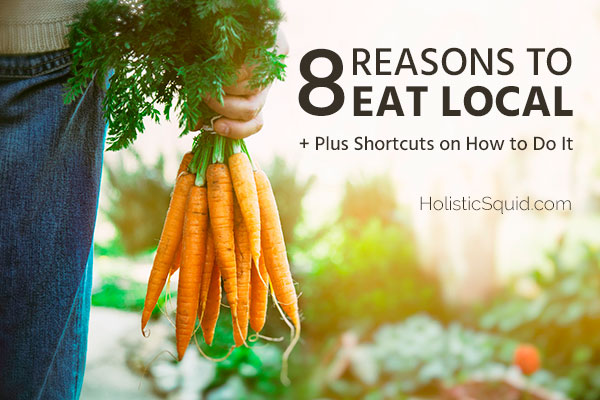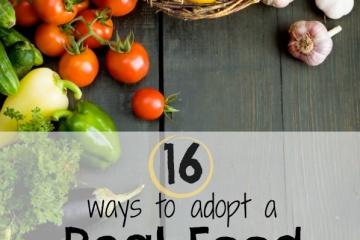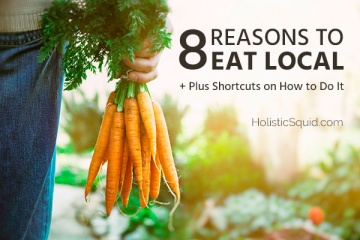
I've talked before about the best ways to support your local foodshed, but I confess, it's super easy to buy for convenience over the doing the “right thing” sometimes. YKWIM? Keeping my best intentions – the reasons for eating local – fresh in my mind helps me to make better choices. Which one of these things below strikes the biggest cord for you? ~Emily
In the past several years there has been a growing “eat local” movement. So what’s behind it? Why would someone go out of their way to eat foods that have been grown in their local environment?
With the change in our food system over the past decades our shift on what is needed for a healthy, nourishing meal has also changed. Eating locally is the beginning of bringing back the connection to our food. So while making these choices may not be the most convenient, here are eight reasons why eating local is worth it.
8 Reasons to eat local
#1 – Local food is safer
The incidence of comtaminated foods is significantly decreased when the foods are grown and harvested near you. According to the Centers for Disease Control there were 22 multistate outbreaks from 2014 to 2015 linked to everything from nut butter spreads, cucumbers, cheese, and the infamous Blue Bell ice cream. These outbreaks occur because of a complicated food system from growth to travel to purchase.
#2 – You'll have more control
When foods are grown locally you have an opportunity to ask the farmer questions about his farming practices. You will know if the food is grown organically or what kind of fertilizers and pesticides are used. This gives you a sense of control over the foods you provide for yourself and your family. Here is a great list of general questions to ask your farmer, from Sustainable Table. Farmers get excited to engage with their consumers and are happy to answer these questions for you.
#3 – The quality of local food is better
Foods that are grown locally are fresher. Produce is picked at its peak, which ensures quality, freshness, profound flavor, and enhanced nutrition. Once separated from their source a higher rate of respiration occurs, resulting in moisture loss, nutrient degradation, and potential microbial spoilage. Supermarket foods are grown and processed with shelf life, not necessarily nutrients, as their main consideration – even organic. Other foods, such as local honey, contain components that aid with managing histamines and allergy conditions.
#4 – There's more variety in local food
Eating locally ensures you will be eating with the seasons. In any given area farmers are subject to grow what the season will support. With this being said, foods taste best when you haven’t had them for a while. Consider how good strawberries taste when you haven’t had them for 9 months. It makes you long for the sweetness and crispness of a fresh, local strawberry.
#5 – Local food tastes better
Foods that are grown locally simply taste better. Have you ever tried a freshly picked tomato? There. Is. No. Comparison. The essence of fresh, local foods meld in your mouth and the flavor profile is as vibrant as their rich color.
#6 – Buying local foods improves your local economy and develops food community
Every time you purchase something that is not from a locally owned business your money is leaving your community. Shopping local keeps money in the community to create local jobs, protects your local culture, and can help a local child with art lessons or sponsor a children’s sports team. Knowing where your food comes from connects you to the people who grow it. You can develop relationships with these people that cannot be created with a grocery store. In addition, you get to create the story of your food, how it was grown, where it came from, and how you plan to use it.
#7 – You can keep your local farmers in business
Much of the food cost going to a farmer goes to cover the transportation, processing, packaging, refrigeration, and marketing of that food. It is estimated that an average farmer receives only 20 cents for every dollar spent. However, a local farmer will receive 100% of the dollars spent, which can go back into the farm to prepare for the next crop or back into your community.
#8 – You can create less environmental impact
The average produce grown in North America spends anywhere from 5 days to several weeks in transit after harvest. According to Michael Pollan, author of the best selling book, Food Rules: An Eaters Manual, the average food item travels approximately 1500 miles and comes from 5 countries to get to your table. Buying local means you eliminate all of the fuel needed for transport.
While there are many reasons to seek out and eat local foods the convenience factor can be a hurdle. There are a few ways to make it a little easier to get local foods. Start with visiting a farmer's market, where the local producers gather to strut their fresh products. Farmer's markets can also be a great gathering to meet up with like-minded foodies and share ideas on how to prepare new items. In addition pairing up with a friend or neighbor to exchange days to travel to a local farmer to gather goods can decrease the burden. You can also consider buying in bulk when the opportunity is available. As for me, right now I have a whole flat of local strawberries in the freezer ready to make smoothies and popsicles.
One of my favorite quotes comes from sustainable food advocate Anna Lappe, “Every time you spend money you are casting a vote for the kind of world you want.” Consider this the next time you buy organic cookies from the store.
Do you make an effort to eat local?
Why or why not?
Daphne Olivier is a registered, yet unconventional dietitian who runs My Food Coach, her nutrition coaching practice. She has a passion for real food and how it affects the body. Daphne works with individuals and groups, in person and online.












Leave a Reply